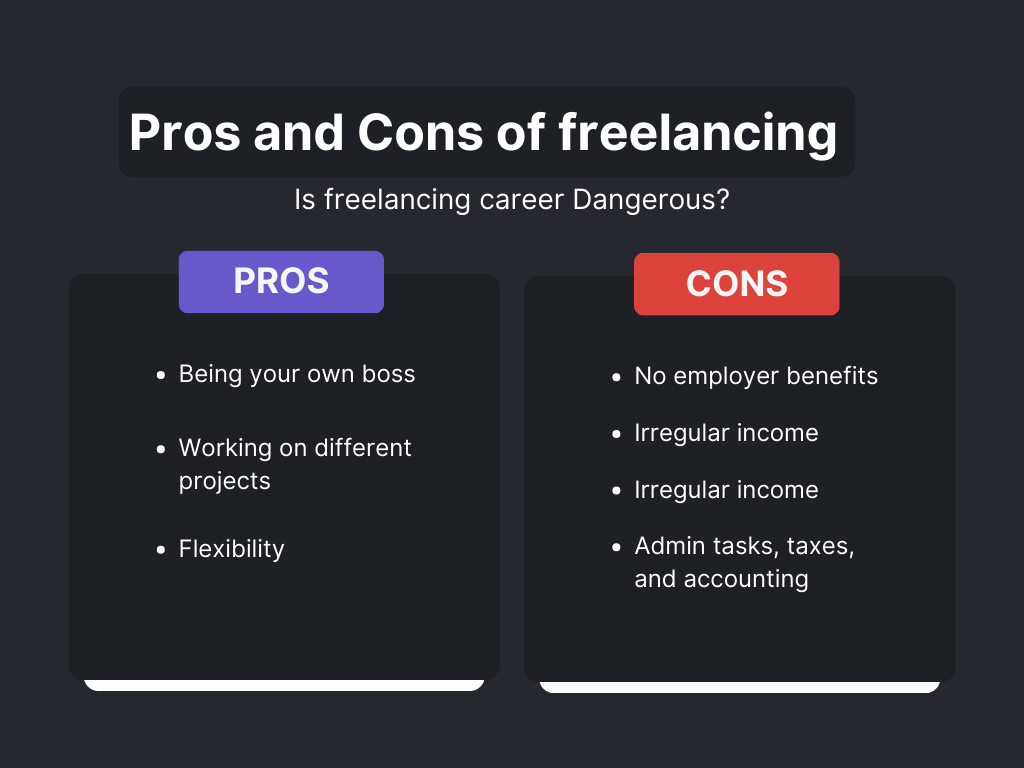Start Freelancing Using Your Existing Skill
Key Highlights
- Freelancing offers the freedom to be your own boss, work on different projects, and have flexibility in your work schedule.
- Starting a freelancing career with no experience is possible by identifying your niche, building an online presence, and developing your skills.
- It is important to set realistic goals, craft a winning freelance profile, and build a portfolio that showcases your best work.
- Strategies for finding your first clients include networking, mastering the art of pitching, and utilizing freelance platforms effectively.
- Managing your freelance business requires setting rates, effective time management, and using tools and technologies for efficiency.
- Growing your freelance business involves continuous learning, expanding your services, and building long-term client relationships.
- Tips for managing freelance and full-time work include checking your work contract, informing your workplace, and maintaining work-life balance.
- Frequently asked questions address topics such as balancing freelancing with a full-time job, finding first freelance clients, and managing time as a freelancer.

Introduction
Have you ever dreamt of a life where you can work on your own terms and enjoy the ultimate financial freedom? If the answer is yes, then freelancing might be the golden ticket you’ve been looking for! Freelancing offers the flexibility to be your own boss, work on different projects, and have control over your work schedule. Whether you are looking to start freelancing as a side hustle or make it your full-time career, it is important to know the steps to get started. In this blog, we will guide you through the process of starting freelancing even when working full-time. We will cover the pros and cons of a freelancing career, how to begin your freelance journey while keeping your day job, laying the foundation for your freelance career, strategies for finding your first clients, managing your freelance business, growing your freelance business, and tips to manage freelance and full-time work. By following these steps and tips, you will be well on your way to building a successful freelancing career.
Pros and cons of a freelancing career

Before diving into freelancing, it is important to understand the pros and cons of this career path. While freelancing offers the benefits of being your own boss, having flexible work hours, and high demand for freelancers, it also comes with challenges such as irregular income and no employer benefits. Understanding these pros and cons will help you make an informed decision about pursuing freelancing as a career.
Pros
There are several advantages to pursuing a freelancing career. Firstly, freelancers have the freedom to be their own boss and make decisions about their work. They have the flexibility to choose the projects they work on, the clients they work with, and the hours they work. Secondly, freelancing offers the opportunity to work on different projects and gain experience in various industries. This variety allows freelancers to continuously learn and develop new skills. Additionally, freelancers are in high demand as businesses increasingly turn to freelancers to fulfill their needs for specialized skills. This high demand creates ample opportunities for freelancers to find work and build a successful career. Overall, freelancing offers the potential for a rewarding and fulfilling career for those who are willing to put in the effort and take advantage of the opportunities available.
#1: Being your own boss
One of the major advantages of freelancing is the ability to be your own boss. As a freelancer, you have the freedom to make decisions about your work, set your own rates, and choose the projects you want to work on. This level of autonomy allows you to have control over your career and work on projects that align with your interests and values. Being your own boss also means that you are responsible for managing your time, setting goals, and ensuring the success of your freelance business. While this level of responsibility may seem daunting, it also offers the opportunity for personal and professional growth. By taking charge of your career and making decisions that align with your vision, you can create a fulfilling and rewarding freelance career.
#2: Working on different projects
Another advantage of freelancing is the opportunity to work on a variety of projects. Unlike traditional full-time employment where you may be limited to working on one specific project or within one industry, freelancing allows you to take on different projects and explore various industries. This variety not only keeps your work interesting and engaging but also allows you to continuously learn and develop new skills. As a freelancer, you have the flexibility to choose projects that align with your interests and strengths, allowing you to grow both personally and professionally. Working on different projects also exposes you to different clients and industries, expanding your network and increasing your chances of finding more work in the future. The ability to work on a variety of projects is one of the key benefits of freelancing and can lead to a fulfilling and dynamic career.
#3: Flexibility
Flexibility is a major advantage of freelancing. As a freelancer, you have the flexibility to choose when, where, and how you work. This flexibility allows you to create a work-life balance that suits your needs and preferences. Whether you prefer to work during traditional office hours or during evenings and weekends, freelancing gives you the freedom to schedule your work according to your own preferences. This flexibility is particularly beneficial for those who have other commitments, such as family responsibilities or a full-time job. Freelancing allows you to work around these commitments and create a schedule that works for you. However, it is important to note that with this flexibility comes the responsibility of managing your time effectively. It is essential to have good time management skills and prioritize your work to ensure that you meet deadlines and deliver high-quality work to your clients. With proper time management, freelancing offers the opportunity to achieve a work-life balance that suits your needs and allows you to enjoy both your personal and professional life.
Cons
While freelancing offers many advantages, there are also some challenges and drawbacks to consider. One of the main challenges of freelancing is the irregular income. Unlike a traditional full-time job where you receive a consistent paycheck, freelancers often experience fluctuations in their income. Some months may be extremely busy and financially rewarding, while other months may be slower and result in lower income. This irregular income can make financial planning and budgeting more challenging. Another drawback of freelancing is the lack of employer benefits. As a freelancer, you are responsible for your own healthcare, retirement plans, and other benefits that are typically provided by employers. This means that you need to take care of these aspects on your own, which can be more expensive and complicated compared to being covered by an employer. Additionally, freelancers are responsible for managing their own taxes and accounting, which can be time-consuming and require additional expertise. Despite these challenges, many freelancers find that the advantages of freelancing outweigh the drawbacks and are able to build successful and fulfilling careers.
#1: No employer benefits
One of the main disadvantages of freelancing is the lack of employer benefits. Unlike traditional full-time employment where employers often provide benefits such as healthcare and retirement plans, freelancers are responsible for securing these benefits on their own. This means that freelancers need to budget for and purchase their own health insurance, contribute to their own retirement plans, and handle other benefits that are typically provided by employers. This can be more expensive and time-consuming compared to being covered by an employer. Freelancers also need to be proactive in managing their own taxes and accounting, which requires additional time and effort. Despite these challenges, many freelancers find that the freedom and flexibility of freelancing outweigh the lack of employer benefits and are willing to take on the responsibility of managing these aspects of their freelance business.
#2: Irregular income
Another drawback of freelancing is the irregular income. Unlike traditional employment where you receive a consistent paycheck, freelancers often experience fluctuations in their income. Some months may be extremely busy and financially rewarding, while other months may be slower and result in lower income. This irregular income can make financial planning and budgeting more challenging. Freelancers need to be prepared for the possibility of lean months and have a strategy in place to manage their finances during these periods. It is important to set aside a portion of your income for savings and create a budget that takes into account the variability of your income. Building a financial cushion can provide a sense of security during slow periods and ensure that you are able to meet your financial obligations. Despite the irregular income, many freelancers find ways to create stability in their finances and enjoy the benefits of freelancing, such as the ability to earn more during busy periods and the potential for higher income compared to traditional employment.
#3: Admin tasks, taxes, and accounting
Freelancing comes with the responsibility of managing administrative tasks, taxes, and accounting on your own. Unlike traditional employment where employers handle these tasks, freelancers need to take care of them independently. This includes tasks such as invoicing clients, tracking expenses, and managing contracts. Freelancers also need to understand and comply with tax laws and regulations, which can be complex and vary depending on the jurisdiction they operate in. Additionally, freelancers need to keep accurate records of their income and expenses for tax purposes and may need to hire an accountant or use accounting software to assist with these tasks. While these administrative tasks may require additional time and effort, they are essential for the successful operation of a freelance business. Freelancers can streamline these tasks by using tools and technology designed for freelancers, such as time tracking software, expense management apps, and invoicing platforms. By efficiently managing administrative tasks, taxes, and accounting, freelancers can focus on their work and ensure the smooth operation of their freelance business.

Beginning Your Freelance Journey While Keeping Your Day Job
Assess your current skills and interests to align with the freelance market demands. Identify viable opportunities that match your expertise. Set achievable goals for your freelance venture considering your time constraints. Balancing a day job and freelancing requires realistic planning to ensure success in both pursuits. It’s crucial to evaluate your capacity and commit to gradual growth in your freelance business. By understanding your strengths and limitations, you can effectively navigate the transition towards freelancing while maintaining stability in your current employment.
1. Assessing Your Current Skills and Interests
Before diving into the freelance world, it’s crucial to assess your current skills and interests. Identify what you excel at and enjoy doing to leverage your strengths in the freelancing business. Consider areas like data entry, content writing, web development, or SEO where you have expertise. Understanding your niche will help you target clients effectively, positioning yourself as a valuable asset in the market. Evaluate your soft skills alongside technical abilities to cater to a diverse range of prospective clients. Utilize online classes or certifications to enhance your skill set for a successful freelance career.
2. Identifying Opportunities in the Freelance Market
Identifying opportunities in the freelance market involves assessing the demand for your skills, exploring niche markets, and understanding where your expertise fits best. Utilize job boards, social media platforms, and online presence to showcase your offerings. Networking, joining relevant Facebook groups, and leveraging platforms like Upwork and Fiverr can help connect with prospective clients. Research the scope of work, target clients, and pricing strategies to position yourself competitively in the freelance world. Stay adaptable and open to learning new skills to capitalize on emerging opportunities.
3. Setting Realistic Goals for Your Freelance Business
Setting realistic goals for your freelance business is crucial for long-term success. Utilize NLP terms like ‘freelance career’ and ‘freelancing business’ to establish achievable milestones. Consider your current workload and commitments when defining these objectives – balance is key. Ensure that your goals align with your skills and experience level to stay motivated. Use platforms like LinkedIn to network with potential clients and set targets for expanding your client base. By setting clear and attainable goals, you pave the path for a thriving freelance venture.

Get Testimonials
It’s crucial to acquire testimonials for your freelance work. Testimonials serve as social proof of your skills and reliability, bolstering your credibility in the freelance world. Positive feedback from clients showcases your ability to deliver quality work and build trust with prospective clients. Displaying testimonials on your website or social media platforms can attract more business opportunities. Request feedback from satisfied clients to create a strong testimonial base that highlights your strengths and capabilities. Testimonials play a significant role in establishing your reputation as a successful freelancer.
Laying the Foundation for Your Freelance Career
Crafting a compelling freelance profile is essential to kickstarting your freelance career. Showcase your skills, expertise, and experience effectively to attract potential clients. Building a portfolio that highlights your best work establishes credibility in the freelance world. Leveraging social media platforms can help you create an online presence, reach a larger audience, and ultimately, land more freelance projects. By focusing on these foundational elements, you can set yourself up for success in your freelancing journey.
4. Crafting a Winning Freelance Profile
Crafting a winning freelance profile is crucial in showcasing your expertise and attracting clients. Highlight your skills, experience, and unique selling points. Use keywords relevant to your niche for visibility on freelance platforms and search engines. Include a professional photo and a compelling bio that reflects your personality. Request testimonials from previous clients to build credibility. Regularly update your profile with new skills and projects to stay competitive in the freelancing market. Your profile acts as your online resume; make it stand out!
Create a website (and portfolio)
Showcase your expertise by creating a professional website and portfolio. Highlight your skills, previous projects, and client testimonials to attract potential clients. Utilize SEO strategies to ensure your website ranks well on search engines. Establish credibility by sharing relevant content on your blog and engaging with your audience on social media platforms. A well-designed website not only serves as a virtual storefront but also demonstrates your commitment to excellence in your freelance work. Stand out in the competitive freelance world with a visually appealing and informative online presence.
5. Building a Portfolio That Showcases Your Best Work
Building a compelling portfolio is crucial in the freelance world. Showcase your best work to attract prospective clients. Highlight your experience level and the scope of work you offer. Tailor your portfolio to target clients in your niche, demonstrating your valuable skills. Including testimonials and relevant work samples can further enhance your portfolio’s impact. Utilize your portfolio as a powerful tool to impress potential clients and secure freelance opportunities. Strengthen your online presence by continually updating and refining your portfolio to reflect your growth and expertise.
6. Leveraging Social Media to Build Your Brand
To establish your presence in the freelance world, leveraging social media is crucial. Platforms like LinkedIn, Facebook groups, and Instagram can showcase your work, attract potential clients, and boost your online presence. Engaging content, consistent updates, and networking within relevant groups can help you stand out. Utilizing SEO strategies, sharing valuable tips, and highlighting your expertise will not only enhance your brand but also attract your target clients. Social media is an excellent way to build credibility, reach a broader audience, and ultimately grow your freelance business.
Balance your full-time job with your part-time freelancing side gigs
If you’re juggling a full-time job along with part-time freelancing, efficiency is key. Setting clear boundaries and realistic goals helps maintain a balance. Allocate specific time slots for each task, optimizing your productivity. Utilize time tracking tools to monitor your activities effectively. Communicate openly with clients about your availability to manage expectations. Remember to prioritize self-care to prevent burnout and maintain optimal performance in both your job roles. Balancing these commitments requires discipline, organization, and effective time management.
Strategies for Finding Your First Clients
Networking is essential for finding your first clients. Connect with professionals in your industry through job boards, LinkedIn, and referrals. Craft a compelling pitch highlighting your skills and experience. Utilize freelance platforms like Upwork and Fiverr to showcase your services. Join relevant Facebook groups to network with potential clients. Consider offering discounted rates for your first few projects to build a client base. Remember, building relationships and delivering quality work are key to securing long-term clients in the freelance world.
7. Networking: The Key to Unlocking Opportunities
Networking plays a pivotal role in the freelance world. Engaging with prospective clients and peers through platforms like LinkedIn or relevant Facebook groups can open doors to opportunities. Building strong connections can lead to referrals and collaborations, expanding your client base. It’s essential to showcase your skills and experience to the right audience. By networking effectively, you can stay updated on industry trends, access new clients, and establish valuable relationships that can propel your freelancing career forward.
8. Mastering the Art of Pitching to Potential Clients
Pitching to potential clients is a crucial skill in the freelance world. It requires a delicate balance of showcasing your expertise while understanding the client’s needs. Research your prospective clients thoroughly, tailor your pitch to their requirements, and highlight how your skills can add value to their projects. Personalize each pitch to demonstrate your genuine interest. Remember, a successful pitch is not just about selling yourself; it’s about building a connection and offering a solution to the client’s needs. Mastering this art can significantly boost your chances of landing your first client.
9. Utilizing Freelance Platforms Effectively
Utilizing freelance platforms effectively is crucial for gaining visibility and securing projects. Platforms like Upwork and Fiverr offer a pool of potential clients seeking various services. Start by creating a compelling profile that highlights your skills and expertise. Actively bid on relevant projects, showcase your past work, and gather positive testimonials to boost your credibility. Engage with the platform’s community, use filters to find suitable opportunities, and ensure your pricing reflects your value. By leveraging these platforms wisely, you can propel your freelancing career forward.
Managing Your Freelance Business
Setting your rates and negotiating contracts is crucial for managing your freelance business effectively. Time management plays a vital role in juggling freelancing with a full-time job. Utilizing tools and technologies can enhance efficiency in your freelance operations. By focusing on these aspects, you can streamline your workflow and ensure the success of your freelance endeavors. These strategies will help you navigate the challenges of balancing freelancing with your existing commitments and responsibilities.
10. Setting Your Rates and Negotiating Contracts
Deciding on rates and negotiating contracts are critical aspects of building a successful freelance business. Research industry standards and consider your experience level when setting rates. Factor in the scope of work, time commitment, and desired income. Negotiate contracts to protect your interests and clearly define terms, payment schedules, and project deliverables. Be confident in discussing rates with clients and be prepared to justify your pricing based on the value you bring. Effective negotiation skills can ensure fair compensation for your services.
11. Time Management Tips for Juggling Freelancing and Full-Time Work
Prioritize tasks by using tools like Trello or Asana to organize deadlines and commitments effectively. Utilize time tracking apps such as Clockify to monitor your work hours efficiently. Set boundaries by establishing dedicated work hours for both freelancing and your full-time job. Batch similar tasks together to minimize context-switching and boost productivity. Ensure to schedule breaks to avoid burnout and maintain a healthy work-life balance. Manage emails and communication by allocating specific time slots during the day. Leverage automation tools for repetitive tasks to save time and streamline processes.
12. Tools and Technologies for Efficient Freelancing
In your journey as a freelancer, utilizing the right tools and technologies is crucial for efficiency and productivity. Project management apps like Trello or Asana can help you stay organized, while time-tracking tools such as Clockify or Toggl can assist in monitoring your work hours. Communication is key, so tools like Slack or Skype enable seamless interactions with clients. Leveraging design software such as Adobe Creative Suite or Canva can enhance your creative output. Make sure to explore and invest in tools that align with your freelance business needs.

Growing Your Freelance Business
Investing in continuous learning is essential for growing your freelance business. Expanding services and offering value-added services can help attract more clients. Building long-term relationships with clients fosters sustained success. Embrace new skills and certifications to stay competitive in the freelance world. Utilize online classes and relevant Facebook groups to enhance your expertise. Networking and referrals play a vital role in expanding your client base. Delivering quality work consistently is key to becoming a successful freelancer.
13. Investing in Continuous Learning and Skill Development
Investing in continuous learning and skill development is essential for a successful freelance career. In the fast-paced world of freelancing, staying updated with the latest trends and technologies can set you apart from your competitors. Taking online classes, attending workshops, and seeking mentorship are great ways to expand your skill set. By dedicating time to learning, you can offer more value to your clients, improve your marketability, and ensure long-term success in the freelance industry.
14. Expanding Your Services and Offering Value-Added Services
Expanding your services as a freelancer is crucial for business growth. By offering value-added services, you can attract more clients and increase your income. Consider broadening your skills through online classes or certifications to provide a wider range of services. Tailoring your services to meet client needs shows professionalism and can lead to long-term relationships. Don’t be afraid to innovate and explore new service offerings to stay competitive in the freelancing market.
15. Building Long-Term Client Relationships for Sustained Success
Building long-term client relationships is vital for sustained success in the freelancing world. By providing consistent quality work and excellent service, you can establish trust and credibility with your clients. Communication is key; keep clients updated, listen to their feedback, and address any concerns promptly. Express appreciation for their business and seek opportunities to add value. Cultivate a professional yet friendly relationship to foster loyalty. Remember, happy clients are more likely to provide referrals and repeat business, paving the way for long-term success.

Tips to Manage Freelance & Full-Time Work
Check Your Work Contract, Inform Your Workplace, Clarify the Benefits of Freelance, Freelance Time and Dime, Consider Networking, Notify Timings to Clients, Work-Life Balance.
1. Check Your Work Contract
Review the terms of your employment contract thoroughly before delving into freelancing. Understand any clauses pertaining to non-compete agreements or conflicts of interest that may hinder your freelance activities. By being aware of these terms, you can navigate the freelancing world while adhering to your work obligations. It’s essential to ensure that your freelance endeavors do not breach any contractual agreements you have with your current employer. This initial check will set a solid foundation for your freelance journey.
2. Inform Your Workplace
Inform your workplace about your freelancing activities. Clearly communicate your intent and ensure compliance with any company policies on side businesses. Transparency fosters trust and avoids potential conflicts of interest. Open dialogue can lead to supportive arrangements wherein you can balance your job responsibilities with your freelance commitments. Be upfront about your freelance workload to manage expectations and deliver quality work consistently. This proactive approach sets a foundation for a harmonious work environment while pursuing your freelance aspirations.
3. Clarify the Benefits of Freelance
When considering freelancing, it’s essential to clarify the benefits it can offer. Freelance work provides autonomy, allowing you to work on your terms. It offers flexibility to schedule work around your day job and personal life. Additionally, freelancing can lead to varied projects and clients, expanding your skills and network. The ability to choose your projects and clients enables you to focus on areas you are passionate about, leading to a more fulfilling work life balance. Understanding these benefits can motivate you to embark on a successful freelance career.
4. Freelance Time and Dime
Freelance time and dime: Freelancing demands not just time allocation but also wise management of finances. Tracking your hours diligently with time-tracking apps helps in billing accurately. Prioritize high-paying gigs to optimize your earnings per hour. Determine your worth by considering your skill level, market demand, and competition. Pricing yourself competitively yet adequately is crucial. Efficient time and dime management sets the foundation for a successful freelance career.
5. Consider Networking
Networking is crucial when starting freelancing. Engage with industry professionals on social media platforms like LinkedIn. Join relevant Facebook groups to connect with potential clients. Attend networking events or webinars to expand your circle. Networking helps you learn from others’ experiences, gain valuable insights, and potentially secure projects. Building strong relationships can lead to referrals and collaborations. By actively networking, you can grow your freelance business and tap into new opportunities. Make networking a consistent practice in your freelancing journey.
6. Notify Timings to Clients
Being transparent about your availability is crucial in freelancing. Clients appreciate knowing when they can expect your deliverables. Setting clear communication channels ensures smooth interactions. Establishing boundaries from the start helps manage expectations for both parties. Updating clients on any potential changes in your schedule demonstrates professionalism and reliability. Effective communication about your working hours fosters trust and understanding. Timely updates on project progress promote a positive client-freelancer relationship. Keeping clients informed of your availability enhances collaboration and project outcomes.
7. Work-Life Balance
Maintaining a healthy work-life balance is crucial when delving into the freelance world. It’s essential to establish boundaries, allocate dedicated time for work and leisure, and stick to a schedule. Avoid overcommitting yourself and be mindful of burnout. Utilize time management techniques to optimize productivity during work hours, allowing yourself to unwind and recharge during personal time. Finding the right balance ensures sustainability and longevity in your freelancing career. Prioritize self-care to prevent potential health issues and maintain your passion for freelancing.

Conclusion
In conclusion, embarking on a freelancing journey while working full-time requires strategic planning and dedication. Assess your skills, set realistic goals, and create a compelling profile to attract clients. Networking, effective pitching, and utilizing freelance platforms are key to securing your first clients. Manage your business efficiently by setting rates, mastering time management, and leveraging tools for productivity. Continuous learning and expanding services will aid in growing your freelance business. Remember, maintaining work-life balance and nurturing client relationships are vital for sustained success in the freelancing world. Transitioning into freelancing can be a fulfilling experience with the right approach and perseverance.
Frequently Asked Questions
How do I balance freelancing with a full-time job?
Balancing freelancing with a full-time job requires effective time management, setting boundaries, and prioritizing tasks. Ensure clear communication with both employers and clients, utilize scheduling tools, and allocate specific hours for each role. Consistency and organization are key.
What are the first steps to start freelancing?
Assess your skills, explore freelance opportunities, and set realistic goals. Craft a compelling profile, build a standout portfolio, and establish your brand on social media. Network actively, perfect your pitching, and utilize freelance platforms effectively. Start freelancing while maintaining your full-time job with these initial steps.
How can I find my first freelance client?
Networking is key to finding your first freelance client. Attend events, join online communities, and leverage social media platforms. Craft a compelling pitch showcasing your skills and expertise. Utilize freelance platforms to explore opportunities. Building relationships and referrals can also lead to client acquisitions.
What tools can help me manage my freelance business?
Utilize tools like project management software (Trello, Asana), time trackers (Clockify, Toggl), invoicing platforms (FreshBooks, QuickBooks), and communication apps (Slack, Zoom) to streamline tasks, track time efficiently, manage finances, and communicate effectively with clients for a successful freelance business.
How do I set my freelance rates?
Determining your freelance rates involves considering factors like your skills, experience, market demand, and desired income. Research industry standards, evaluate your worth, and be flexible yet competitive. Communicate value to clients to justify your rates effectively.
Is it necessary to niche down in freelancing?
Narrowing down your freelancing niche can help you stand out and attract specific clients. While not mandatory, specializing in a niche can enhance your expertise, portfolio, and opportunities for higher-paying projects. It’s essential to weigh the benefits against potential limitations before deciding.
How can I use social media to benefit my freelance career?
By harnessing social media, freelancers can showcase their work, engage with potential clients, and build their brand. Utilize platforms like LinkedIn, Instagram, and Twitter to connect with your audience, share insights, and attract new opportunities. Enhance your freelance career through strategic social media utilization.
What are some common challenges in freelancing and how to overcome them?
Challenges in freelancing include inconsistent income, lack of benefits, and managing administrative tasks. Overcome them by setting aside emergency funds, researching healthcare options, and using productivity tools. Balancing workloads and prioritizing tasks efficiently are key strategies.
How important is networking in freelancing?
Networking is crucial in freelancing as it opens doors to opportunities, collaborations, and client referrals. Building a strong network can lead to a steady flow of projects and long-term partnerships, enhancing your freelance career growth. Embrace networking to expand your reach and thrive in the freelancing world.
Can I start freelancing with no experience?
Yes, you can start freelancing with no experience by leveraging your skills, learning on the job, and building a strong portfolio. Networking and utilizing freelance platforms can help kickstart your freelance career even without prior experience.
What are the best practices for managing time as a freelancer?
Assess your workload, set clear priorities, schedule tasks efficiently, use time-tracking tools, and establish boundaries between work and personal life. Effective time management is crucial for balancing freelance projects with a full-time job. Prioritize tasks based on deadlines and importance to boost productivity.
How can continuous learning impact my freelance career?
Continuous learning is crucial for freelancers to stay competitive in the ever-evolving market. Acquiring new skills and staying updated can lead to better opportunities, improved quality of work, and increased client satisfaction. Embrace learning as a key strategy for long-term success in your freelance career.
